Hoping to see artwork by famous Renaissance artist Sandro Botticelli but unsure what to look for or where to go? Don’t worry, our guides are Botticelli experts! To help you out, we share Botticelli’s most famous paintings and where to see them. Hint: head to the Uffizi in Florence!
Pro Tip: Planning to see Botticelli’s artwork at the Uffizi in Florence? Bookmark this post in your browser so you can easily find it when you need it. Check out our Uffizi Gallery Guide for more planning resources and our best Uffizi tours to see Botticelli’s masterpieces with an expert guide.
The 11 Most Famous Artworks By Botticelli
First of all, let’s introduce Botticelli and his career. For starters, his real name was Alessandro di Mariano di Vanni Filipepi. He was born in 1444/5 in Florence, where he lived for the majority of his life.
According to art historian Barbara Deimling, he trained as a goldsmith between 1459/60. However, two years later, he decided to become a painter under the tutelage of Fra Filippo Lippi in Prato, which ended in 1467. Fra Filippo was a Carmelite monk, so the influence of religious art was constant throughout Botticelli’s formative years.
Work on the Sistine Chapel and Medici patronage
In 1470, he started his own studio. Perhaps the most important moment in his career, however, happened in 1475 when he earned the patronage of the Medici family. In fact, this would sustain his career for many years to come.
In 1481, he left Florence for Rome to work on the Sistine Chapel. After, he returned shortly to his studio. We know he continued to paint into his 60s because he paid fees at artisan guilds. However, the last of these payments was made in 1505.
Decline and rediscovery
It seems old age was not kind to him and by the time of his death in 1510, he was rather poor and in bad shape. His sudden decline accompanied by other historical circumstances has made him a hard artist for historians to understand.
Botticelli’s style was deeply impacted by late Gothic art. This, according to Jean Gillies, made him quite forgettable during the 1500s due to shifting artistic tendencies. So, just a few years after his death, he faded into the background.
It wasn’t until the 19th century when the pre-raphaelites rediscovered him that his work regained popularity amongst art historians. With this in mind, let’s look at the most famous of his paintings and where you can see Botticelli’s work for yourself.
Not ready to book a tour? Find out if an Uffizi Gallery tour is worth it.
11. St Sebastian
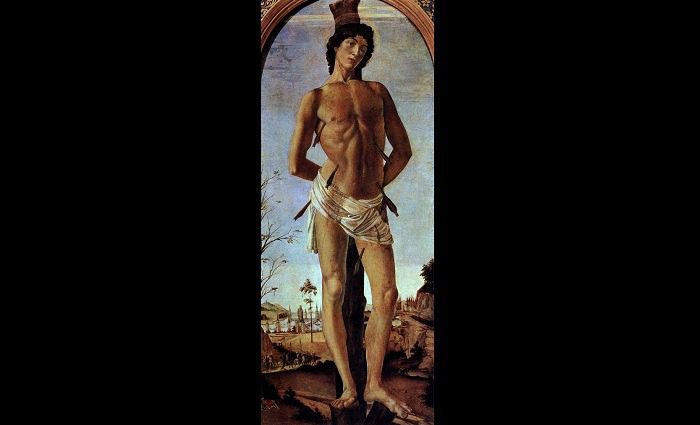

1474 | Tempera on panel | Gemäldegalerie (Berlin)
The image of this saint is very precarious. Botticelli painted a very tall, slender, and sort of scrawny figure clearly in suffering. According to Emile Gebhart and Victoria Charles, Botticelli here references Donatello’s canon of proportions. This meant creating a slightly exaggerated slender figure, contrary to what his master taught him—full, rounded bodies. In doing this, he achieves a sense of majesty in the depiction of the human figure.
It’s important to understand the historical context to appreciate why Botticelli would have painted this saint. According to Barbara Deimling, during this time St. Sebastian was one of the most venerated saints in Italy as patron of those infected by the plague.
Deimling suggests this painting was probably an expression of gratitude for being spared from the plague. It’s not a very common motif, so hopefully, you will remember it in this collection.
Where to see it: Gemäldegalerie, Berlin
10. Annunciation
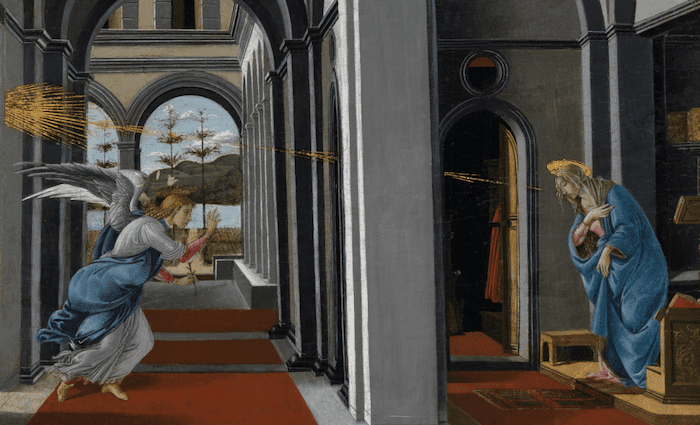

1490 | Tempera on panel | Kelvingrove Art Gallery and Museum (Glasgow)
This painting by Botticelli presents a variant of the Annunciation where the Virgin Mary is reading and the angel appears to bring the news that she is pregnant with the child of God.
We think Botticelli took inspiration for this painting from Verrochio, who was Leonardo da Vinci’s teacher. However, this motif of Mary and the angel was likely something he learned from his master Fra Filippo, who also created an annunciation with this same style.
The most striking element of this painting is the use of architectural features to frame the narrative. You can see this in the position of the columns, the arches, and the flooring, which create a very interesting perspective and give the impression that this could be a real building.
The Annunciation has been one of the most common religious Christian art motifs since the Middle Ages. Almost every grandmaster has a piece on the Annunciation. So, we understand this piece as one of the stepping stones in Botticelli’s artistic career.
He also created other versions of the Annunciation. And you can see one of these, the Cestello Annunciation, which is a more simplified composition, at the Uffizi (Florence), and another one in the Metropolitan in New York.
Where to see it: Kelvingrove Art Gallery and Museum, Glasgow
9. Callumny of Apelles
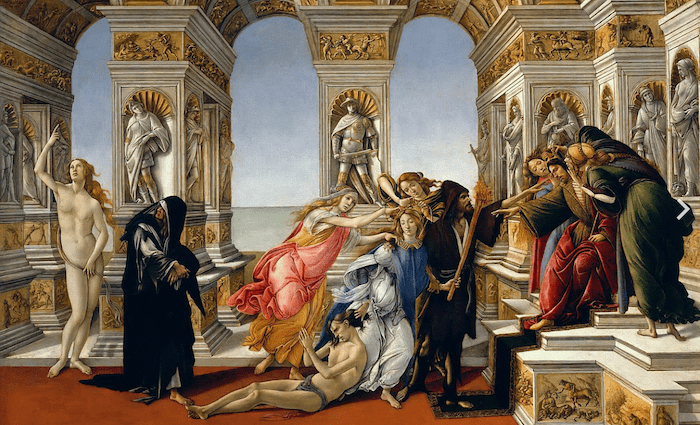

1494-5 | Tempera on panel | Uffizi (Florence)
This is one of Botticelli’s most famous paintings because it is his best depiction of the ekphrasis genre. An ekphratic painting is a rhetorical device that tries to relate to another art medium and recreate its essence and form.
It’s a mixture between adaptation and synergy. Here, Botticelli is trying to recreate a lost painting from the ancient Greek artist Apelles based purely on a description found in commentaries by Pliny the Elder and Lucian.
The figures represent vices and virtues. This is a very complex painting with many meanings and allegories that are still difficult for art historians to digest. This is because we don’t know who exactly it was intended for. Unfortunately, as the original painting is also lost, we cannot draw many comparisons between the two.
Planning a trip to Florence? Don’t go with a big group to the Uffizi. Instead, check out our small group tours that allow you to connect with your guide and really understand the artwork.
Where to see it: Uffizi Gallery, Florence
Not ready to book a tour? Read more about how to visit the Uffizi Gallery.
8. Portrait of Smeralda Bandinelli
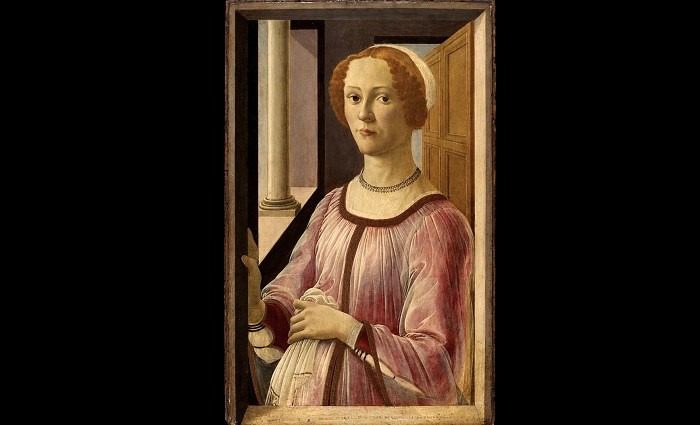

c. 1470 | Tempera on panel | Victoria and Albert Museum (London)
Botticelli was among the first wave of artists in the Renaissance to change portraits, which encouraged artists to work on three-quarter portraits. This trend was started by Flemish artists.
In the 1470s, Botticelli worked on several projects where he innovated with his artistic facial expressions. But for this portrait, specifically, he added a new feature.
Patricia Zambrano explains that he presents the portrait as if it is seen through an opening and in an architectural setting. This was a type of feature that he mastered and used frequently, so Botticelli gave it a new space in portraiture.
Also, according to Zambrano, this is the first known female portrait of this kind. Costaras and Richardson explain that this painting was repaired by Rossetti in the 19th century and somehow altered. They also state that Botticelli added oil to his tempera paintings to give them more of a sophisticated range of effects, and that is visible in this painting.
Where to see it: Victoria and Albert Museum, London
7. Madonna of the Magnificat
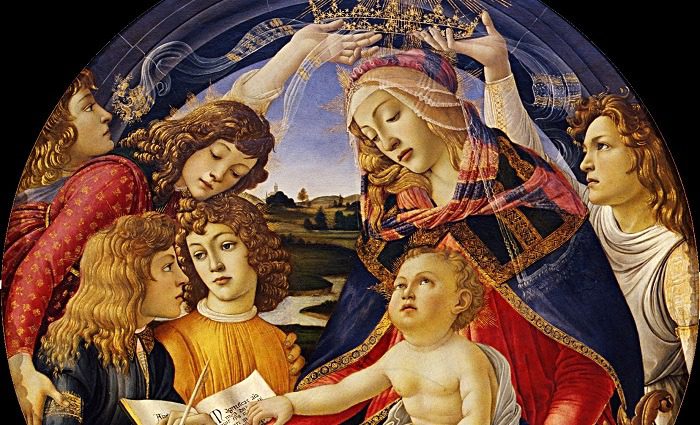

1481 | Tempera tondo | Uffizi (Florence)
This is a painting of Madonna and the child, with the virgin holding a pomegranate—a symbol of resurrection, according to Carlo Montresor. It shows that Botticelli had great knowledge of movement, which can be seen both in the bodies of the Madonna and Jesus and in the landscape in the background, specifically the river.
The name of the painting comes from the page baby Jesus is holding over his mother’s arm–there, you’ll see the words for the Magnificat. In fact, according to Schibanoff, the Madonna is represented here not as a passive reader, as most virgins with a child and book are.
Instead, if you look closely, you’ll see she’s holding a pen and writing this Magnificat text. Again, another mysterious and unusual touch of Botticelli in this painting has created much debate amongst historians.
Where to see it: Uffizi Gallery, Florence
Not ready to book a tour? See our Uffizi Gallery Guide for more info.
6. The Tragedy of Lucretia
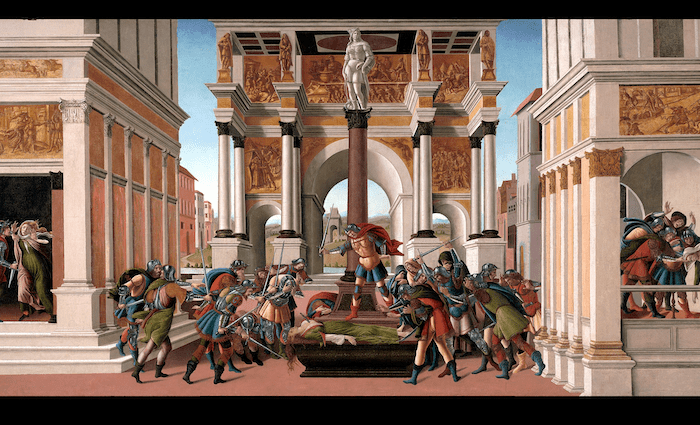

1496-1504 | Tempera and Oil on Wood | Isabella Stewart Gardner Museum (Boston)
The painting is a dramatic representation of the raping of Lucretia by Sextus Tarquinius, the son of the last king of Rome. The ravaging of Lucretia starts on the panel on the left.
The centre panel represents the burial of Lucretia and the men of Rome taking arms and rebelling against the powers of the city for such a felony. This eventually leads to the founding of the roman republic.
On the right-hand panel, Lucretia appears to take her own life after she reveals what has happened to her. Botticelli uses the building to set the scene almost as if it were a tryptic in three sections, which is a very clever way of displaying perspective and storytelling.
It’s unclear whether the building represents old Rome or a landscape contemporary to Botticelli. According to Barbara Deimling, Botticelli uses this story to allude to contemporary historical events, particularly the ousting of the Medici, who were his patrons, and the introduction of the Florentine republic. This, then, was a very political painting for him, particularly considering his general standing in mythology and religious art.
Where to see it: Isabella Stewart Gardner Museum, Boston
5. Youth of Moses
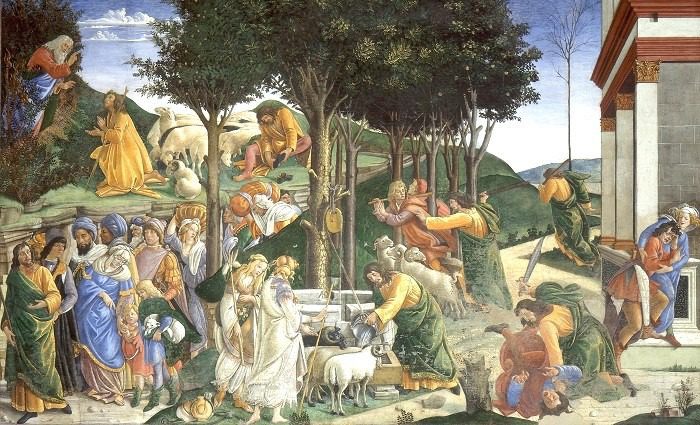

1481-2 | Fresco | Sistine Chapel (The Vatican)
Also known as The Trials of Moses. This is part of a series of frescoes showing several scenes from Exodus commissioned by the Renaissance popes to adorn the Sistine Chapel. Botticelli was one of many artists who participated in this project.
This was also one of the very few times where he actually worked outside of Florence. Because the project was so big, he actually used his apprentices to help him create the scenes much the same as Michelangelo did for the Sistine Chapel.
Moreover, he and his team created a total of three frescoes telling the stories of Moses and Jesus. You can always tell who is Moses in these frescoes because his tunic is yellow and he wears a green cloak. The importance of these paintings is mainly in the magnitude of the work and their location in this room.
There’s more to the Sistine Chapel than meets the eye. If you want to have the privilege of seeing the Sistine Chapel ahead of the crowds, check out our early-access Vatican tours with a guide who really knows their stuff.
Where to see it: Sistine Chapel, Vatican
Not ready to book a tour? Find out how to visit the Sistine Chapel.
4. Adoration of the Magi
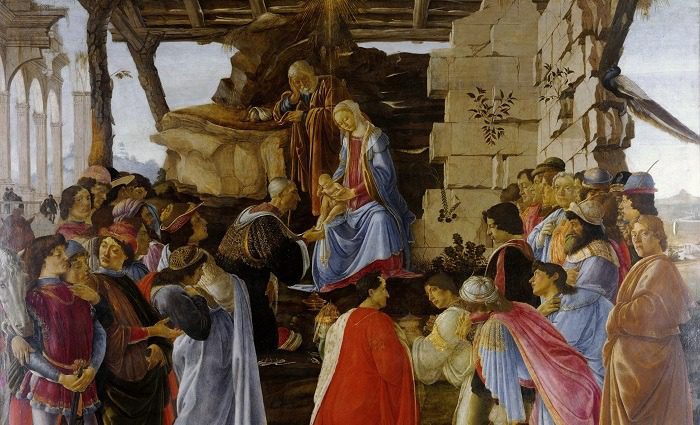

1476 | Tempura on panel | Uffizi (Florence)
According to Carlo Montresor, this is a crucial artistic step in Botticelli’s career as a painter. It helped him find his way and his voice as an artist. However, the reason why this painting is most famous is because of the depiction of some famous people of the time.
According to Isabella Alston, the magi are painted as Cosimo de Medici and his sons, Piero and Giovanni, all of whom were already dead at the time of the painting. It was his first introduction to the Medici family and, therefore, the prospect of a lucrative future ahead.
Finally, Barbara Deimling states that the retinue of the magi is painted in very luxurious clothes. This is reflective of the parades of the Florentine brotherhood of the magi who imitated the procession of the magi from the Bible. So, this painting helps us understand some cultural celebrations in Florence during this period.
Where to see it: Uffizi Gallery, Florence
Not ready to book a tour? Find out how to visit the Uffizi Gallery.
3. The Mystical Nativity
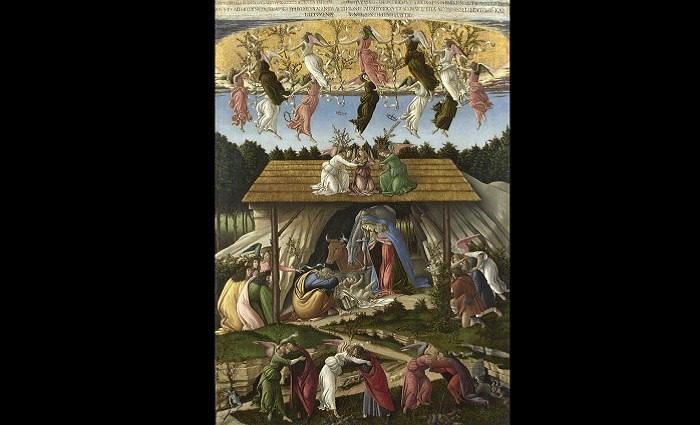

c. 1500-1| Oil on canvas | National Gallery (London)
This is the only painting Botticelli signed. As a depiction of the nativity scene, it shows some unusual iconography. Anyone familiar with a nativity scene of any medium would know the three wise men brought Jesus gifts.
However, there are no presents here. Christ also seems rather distressed. According to art historian Jonathan Nelson, the depiction of the angels and demons also has a resonance with paintings of the Last Judgment and the Apocalypse. So, perhaps Botticelli was alluding to the fact that Christ would return and judge our souls.
This coincides perfectly with the timeframe in which Botticelli was associated with a radical Christian preacher called Girolamo Savonarola. He was very vocal against the ruling despots of Italy and the treatment of the poor and secular art and vanities.
His calls for a renovation of Christianity had a feeling of doom looming. They seemed to come true as the first Italian War of 1494-98 took place, which eventually lead to the removal of the Medici as the ruling family in Florence.
Interestingly, Savonarola was later excommunicated by the Pope and hanged. His radical preaching is definitely something Botticelli sympathized with and is exemplified in this painting.
Where to see it: National Gallery, London
2. Primavera
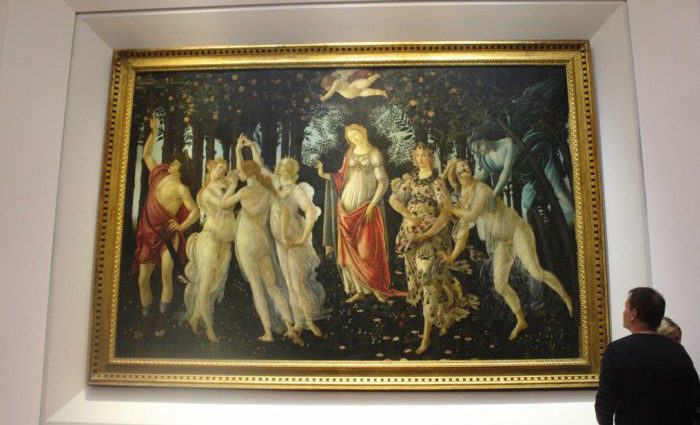

c. 1479-80 | Tempera on panel | Uffizi (Florence)
This is the largest mythological painting created in the early Renaissance. According to Isabella Alston, perhaps this was conceived as a painting to commemorate a wedding.
The themes of love and marriage seem to resonate with this. However, Jean Gillies suggests this is one of the most debated paintings in history. In fact, scholars often considered it rather enigmatic.
Nevertheless, art historians concur that this painting represents the deep impact humanism had on Renaissance artists such as Botticelli. Also, if we accept the traditional interpretation that the painting was commissioned by the Medici, we can also see traces of these patrons and their ideologies.
The Medici were firm believers of Neoplatonism, which merged Christian ideology with Plato’s philosophies. This could have added to the mysticism of the iconography used in the painting.
Furthermore, according to Jean Gillies, recent inventories discovered suggest the painting was done for Lorenzo de Medici, or at least that it was in his possession for a long time. So, it must have had some meaning to him.
According to Carlo Montresor, these inventories referred to it as the garden of Atlantis or the garden of the Hesperides. This makes sense if we consider that Botticelli never gave a name to this painting. The name “Primavera” comes from accounts written by Vasari where he calls it bythis name.
Where to see it: Uffizi Gallery, Florence
Not ready to book a tour? Check out our Uffizi Gallery Guide for more info.
1. The Birth of Venus
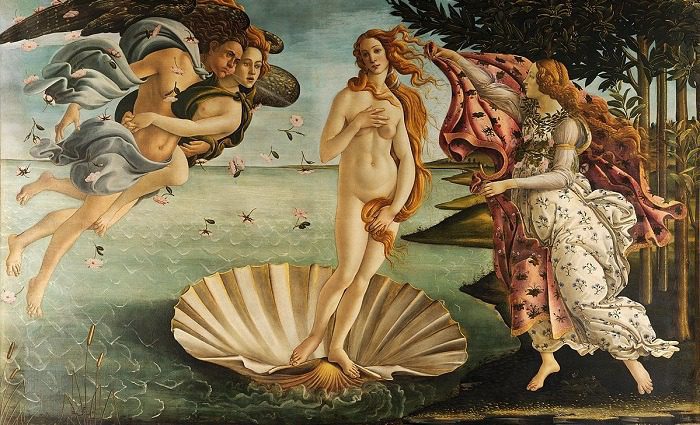

1484-6 | Tempera on canvas | Uffizi (Florence)
This is the most iconic of his paintings thanks to the popularity it has gained in recent years. According to Isabella Alston, it is historically the first work in tempera on canvas created in Tuscany.
Another incredible feature Botticelli added to this painting was the alabaster powder he added to his paints to make the colors pop and act as a preservative at the same time.
According to Isabella Alston, the body of this venus and its sensuality simulates marble statues of the goddess. This explains the emphasis on making it as pale and marble-like as possible. Her modest stance as she tries to cover herself is a direct reference to the Venus Pudica of classical art.
Most art historians believe this is a very allegoric painting that draws inspiration from Ovid’s metamorphosis stories. Isabella Alston suggests that the model for this painting may have been Simonetta Cattaneo Vespucci, who was his love interest.
Unfortunately, she died young (21) of suspected tuberculosis. The fact that he never married and asked to be buried at the foot of her grave emphasizes his adoration for this woman and she may have been the inspiration for this Venus.
Now that you understand Botticelli better, you can more fully appreciate the exceptional work of Botticelli. If you want to see The Birth of Venus and other artworks on this list, plan a visit to the Uffizi in Florence.
Where to see it: Uffizi Gallery, Florence
Not ready to book a tour? Find out if an Uffizi Gallery tour is worth it.

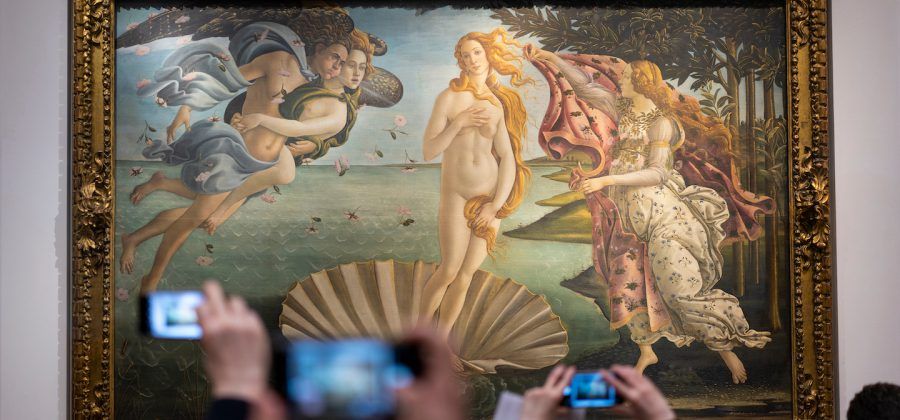
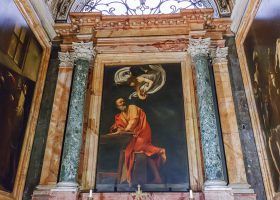
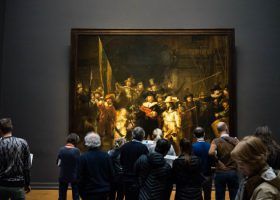
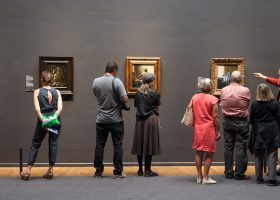
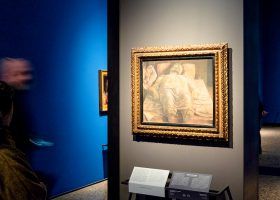
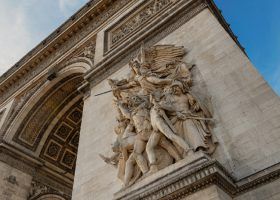
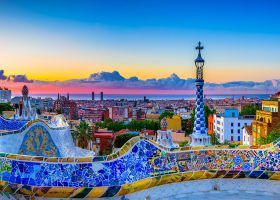


Leave a Comment